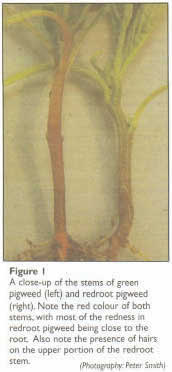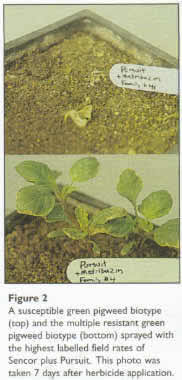
Pigweed populations with stacked herbicide resistance have the potential to create additional weed management problems for growers in Ontario. Testing conducted at the Department of Plant Agriculture at the University of Guelph has revealed a population of green pigweed that can survive applications of both Pursuit and Atrazine. This marks the first known case of this type of multiple resistance in green pigweed.
 Green
pigweed, like its cousin redroot pigweed, is very abundant in Ontario. Green
pigweed can be identified by its red, hairless stem, its shiny, dark green
leaves, and its long, spiny seed head. The differences in the stem can be
seen even when the plants are young (Figure 1). Pigweeds are very competitive
annual weeds that have the potential to significantly reduce yields of crops
they are competing with, and therefore must be controlled effectively.
Green
pigweed, like its cousin redroot pigweed, is very abundant in Ontario. Green
pigweed can be identified by its red, hairless stem, its shiny, dark green
leaves, and its long, spiny seed head. The differences in the stem can be
seen even when the plants are young (Figure 1). Pigweeds are very competitive
annual weeds that have the potential to significantly reduce yields of crops
they are competing with, and therefore must be controlled effectively.
Triazine resistance was first discovered in Ontario in 1974, with lambsquarters and green pigweed among the first resistant weed species identified. By the late 1980s, approximately 10 weed species in Ontario were recognized as having triazine resistance. Today, triazine resistance accounts for approximately one-quarter of the documented herbicide resistance cases worldwide. With the rapidly increasing number of triazine resistant weeds, new herbicide options and management strategies needed to be adopted by Ontario farmers. For various reasons, the practice of having corn monocultures being sprayed with high rates of atrazine was no longer desirable.
Group 2 herbicides were
first introduced in Ontario in the early 1990s and have been widely adopted,
in large part due to the increasing importance of soybeans in this province.
Some common Group 2 herbicides used in Ontario include Broadstrike, Classic,
Pinnacle and Pursuit for use in soybeans, and Accent, Elim, Peak and Ultim
in corn. It wasn't long until Ontario farmers dependence on Group 2 herbicides
grew, a consequence of these products low use rates (compared to many older
herbicides like atrazine), excellent weed control, wide range of crop registrations,
environmental safety, and low mammalian toxicity.
However, with the increased use of Group 2 herbicides, resistant weeds soon
appeared. To date, there have been many Group 2-resistant weed species discovered,
accounting for approximately one-quarter of the world's herbicide-resistant
weeds. Research initiated in 1998 at the University of Guelph confirmed the
first biotypes of both green and redroot pigweed species in Ontario having
resistance to at least one Group 2 herbicide. The resistant samples were collected
from a dozen separate locations across southwestern Ontario, indicating the
widespread existence of Group 2 herbicide resistance in pigweed species.
Because Group 2 herbicides were likely to be used on weeds that were already
triazine resistant, we hypothesized that multiple resistance could become
a real possibility. Multiple resistance occurs when a weed possesses two or
more distinct resistance mechanisms, enabling that plant to survive herbicides
that work on different biochemical targets in the plant. Weed biotypes possessing
multiple resistance pose a particular problem to growers by drastically reducing
the number of active herbicides that can be used to control them.
To date, there have been
only two documented cases in North America of weeds with multiple resistance
to triazine and  Group
2 herbicides. The first was reported in 1998 from a farm in Illinois, U.S.A.,
where a common waterhemp biotype was found to be resistant to Atrazine, Pursuit,
Pinnacle and Broadstrike. A kochia biotype was also discovered in Illinois
in 1999, and was revealed to be resistant to Atrazine, Pursuit, Pinnacle and
other Group 2 herbicide but not in Ontario. In the winter of 1999, pigweed
samples collected from Ontario farms were screened for the potential existence
of biotypes that have multiple resistance to Atrazine and Group 2 herbicides.
A green pigweed biotype that was collected from a farm in Perth County was
identified as being able to survive the recommended field rate of either Pursuit
or Atrazine. It was further found that the biotype could survive the mixture
of both Pursuit and Atrazine (Patriot), as well as Pursuit plus Sencor/Lexone
(Conquest) (Figure 2). Increasing the herbicide doses above the labelled field
rates has little effect on this pigweed biotype because of its strong immunity
to these herbicides.
Group
2 herbicides. The first was reported in 1998 from a farm in Illinois, U.S.A.,
where a common waterhemp biotype was found to be resistant to Atrazine, Pursuit,
Pinnacle and Broadstrike. A kochia biotype was also discovered in Illinois
in 1999, and was revealed to be resistant to Atrazine, Pursuit, Pinnacle and
other Group 2 herbicide but not in Ontario. In the winter of 1999, pigweed
samples collected from Ontario farms were screened for the potential existence
of biotypes that have multiple resistance to Atrazine and Group 2 herbicides.
A green pigweed biotype that was collected from a farm in Perth County was
identified as being able to survive the recommended field rate of either Pursuit
or Atrazine. It was further found that the biotype could survive the mixture
of both Pursuit and Atrazine (Patriot), as well as Pursuit plus Sencor/Lexone
(Conquest) (Figure 2). Increasing the herbicide doses above the labelled field
rates has little effect on this pigweed biotype because of its strong immunity
to these herbicides.
The significance of finding
this multiple resistant green pigweed biotype in Ontario is twofold. First,
we now know that multiple resistant weed biotypes do exist here in Ontario,
and there are probably more that have not yet been discovered. Second, this
finding should reinforce the fact that herbicide choice, rotation and mixtures
are very important. It is easier to be proactive and try to prevent herbicide
resistance from occurring than it is to fix the problem after resistance has
appeared.
Once multiple resistant weeds have been selected for, chemical control may
no longer be an option for growers. Since Ontario farmers have a significant
dependence on both Group 2 and triazine herbicides, especially in a corn-soybean
rotation, there will be a need for other mechanical or cultural control methods.
A false sense of security may be placed in the increasing number of genetically
modified crops that are resistant to non-selective herbicides like Roundup
or Liberty. Although this may seem to be the solution for controlling multiple
resistant weeds now, who is to say that the increased use and dependence on
these products won't also promote resistance. The key will be for growers
to balance their crop and herbicide rotations and, at the very least, use
tank mixtures and not base all of their weed control methods on one or two
herbicides.
Shane Diebold
is a Master's student and Dr. François Tardif is a professor of weed
science in the Department of Plant Agriculture at the University of Guelph.
Note: Growers who believe they have resistant weeds on their farms can contact
Dr. Tardif at the University of Guelph (519-824-4120 *3395) to inquire about
methods for confirming the presence of resistant weeds.